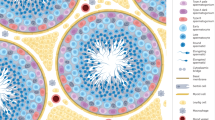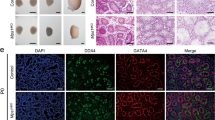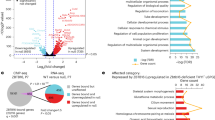Abstract
Little is known of the molecular mechanisms whereby spermatogonia, mitotic germ cells of the testis, self-renew and differentiate into sperm1,2. Here we show that Zfp145, encoding the transcriptional repressor Plzf, has a crucial role in spermatogenesis. Zfp145 expression was restricted to gonocytes and undifferentiated spermatogonia and was absent in tubules of W/Wv mutants that lack these cells. Mice lacking Zfp145 underwent a progressive loss of spermatogonia with age, associated with increases in apoptosis and subsequent loss of tubule structure but without overt differentiation defects or loss of the supporting Sertoli cells. Spermatogonial transplantation experiments revealed a depletion of spermatogonial stem cells in the adult. Microarray analysis of isolated spermatogonia from Zfp145-null mice before testis degeneration showed alterations in the expression profile of genes associated with spermatogenesis. These results identify Plzf as a spermatogonia-specific transcription factor in the testis that is required to regulate self-renewal and maintenance of the stem cell pool.
This is a preview of subscription content, access via your institution
Access options
Subscribe to this journal
Receive 12 print issues and online access
$259.00 per year
only $21.58 per issue
Buy this article
- Purchase on SpringerLink
- Instant access to full article PDF
Prices may be subject to local taxes which are calculated during checkout





Similar content being viewed by others
Accession codes
References
McLaren, A. Germ and somatic cell lineages in the developing gonad. Mol. Cell. Endocrinol. 163, 3–9 (2000).
de Rooij, D.G. Proliferation and differentiation of spermatogonial stem cells. Reproduction 121, 347–354 (2001).
Costoya, J.A. & Pandolfi P.P. The role of promyelocytic leukemia zinc finger and promyelocytic leukemia in leukemogenesis and development. Curr. Opin. Hematol. 8, 212–217 (2001).
Barna, M. et al. Plzf mediates transcriptional repression of HoxD gene expression through chromatin remodeling. Dev. Cell. 3, 499–510 (2002).
Cook, M. et al. Expression of the zinc-finger gene PLZF at rhombomere boundaries in the vertebrate hindbrain. Proc. Natl. Acad. Sci. USA 92, 2249–2253 (1995).
Barna, M., Hawe, N., Niswander, L. & Pandolfi, P.P. Plzf regulates limb and axial skeletal patterning. Nat. Genet. 25, 166–172 (2000).
Shaknovich, R. et al. The promyelocytic leukemia zinc finger protein affects myeloid cell growth, differentiation, and apoptosis. Mol. Cell. Biol. 18, 5533–5545 (1998).
Coulombre, J.L. & Russell, E.S. Analysis of the pleiotropism at the W locus in the mouse: The effects of W and Wv substitution upon postnatal development of germ cells. J. Exp. Zool. 126, 277–296 (1954).
Beumer, T.L., Roepers-Gajadien, H.L., Gademan, I.S., Kal, H.B. & de Rooij, D.G. Involvement of the D-type cyclins in germ cell proliferation and differentiation in the mouse. Biol. Reprod. 63, 1893–1898 (2000).
Wrobel, K.H., Bickel, D. & Kujat, R. Immunohistochemical study of seminiferous epithelium in adult bovine testis using monoclonal antibodies against Ki-67 protein and proliferating cell nuclear antigen (PCNA). Cell Tissue Res. 283, 191–201 (1996).
Beumer, T.L. et al. Regulatory role of p27kip1 in the mouse and human testis. Endocrinology. 140, 1834–1840 (1999).
Narula, A. et al. Smad4 overexpression causes germ cell ablation and leydig cell hyperplasia in transgenic mice. Am. J. Pathol. 161, 1723–1734 (2002).
Handel, M.A., Cobb, J. & Eaker, S. What are the spermatocyte's requirements for successful meiotic division? J. Exp. Zool. 285, 243–250 (1999).
Gown, A.M. & Willingham, M.C. Improved detection of apoptotic cells in archival paraffin sections: immunohistochemistry using antibodies to cleaved caspase 3. J. Histochem. Cytochem. 50, 449–454 (2002).
Brinster, R.L. & Zimmermann, J.W. Spermatogenesis following male germ-cell transplantation. Proc. Natl. Acad. Sci. USA 91, 11298–11302 (1994).
Brinster, R.L. & Avarbock, M.R. Germline transmission of donor haplotype following spermatogonial transplantation. Proc. Natl. Acad. Sci. USA 91, 11303–11307 (1994).
Orwig, K.E., Shinohara, T., Avarbock, M.R. & Brinster, R.L. Functional analysis of stem cells in the adult rat testis. Biol. Reprod. 66, 944–949 (2002).
Yeyati, P.L. et al. Leukemia translocation protein PLZF inhibits cell growth and expression of cyclin A. Oncogene 18, 925–934 (1999).
McConnell, M.J. et al. Growth suppression by Acute Promyelocytic Leukemia-Associated protein PLZF is mediated by repression of c-myc expression. Mol. Cell. Biol. 23, 9375–9388 (2003).
Venables, J.P. & Eperon, I. The roles of RNA-binding proteins in spermatogenesis and male infertility. Curr. Opin. Genet. 9, 346–354 (1999).
Andersson, S. Molecular genetics of androgenic 17 beta-hydroxysteroid dehydrogenases. J. Steroid. Biochem. Mol. Biol. 55, 533–534 (1995).
Scott, K.L. & Plon, S.E. Loss of Sin3/Rpd3 histone deacetylase restores the DNA damage response in checkpoint-deficient strains of Saccharomyces cerevisiae. Mol. Cell. Biol. 23, 4522–4531 (2003).
Inoue, N. et al. New gene family defined by MORC, a nuclear protein required for mouse spermatogenesis. Hum. Mol. Genet. 8, 1201–1207 (1999).
Cunningham, D.B., Segretain, D., Arnaud, D., Rogner, U.C. & Avner, P. The mouse Tsx gene is expressed in Sertoli cells of the adult testis and transiently in premeiotic germ cells during puberty. Dev. Biol. 204, 345–360 (1998).
Labbaye, C. et al. PLZF induces megakaryocytic development, activates Tpo receptor expression and interacts with GATA1 protein. Oncogene 21, 6669–6679 (2002).
Buaas, F.W. et al. ZFP145 is required in adult male germ cells for stem cell self-renewal. Nat. Genet. advance online publication, 23 May 2004 (doi:10.1038/ng1366).
Cooke, H.J. & Saunders, P.T. Mouse models of male infertility. Nat. Rev. Genet. 3, 790–801 (2002).
Manova, K., Nocka, K., Besmer, P. & Bachvarova, R.F. Gonadal expression of c-kit encoded at the W locus of the mouse. Development. 110, 1057–1069 (1990).
Shinohara, T., Orwig, K.E., Avarbock, M.R. & Brinster, R.L. Spermatogonial stem cell enrichment by multiparameter selection of mouse testis cells. Proc. Natl. Acad. Sci. USA 97, 8346–8351 (2000).
Rajasekhar, V.K. et al. Oncogenic Ras and Akt signaling contribute to glioblastoma formation by differential recruitment of existing mRNAs to polysomes. Mol. Cell. 12, 889–901 (2003).
Acknowledgements
We thank A. Viale for advice and discussion regarding microarray analysis; the Molecular Cytology, Flow-Cytometry, Transgenic and Genomic Core facilities, particularly C. Farrell and R. Lester, for technical assistance; E. Pikarsky and X. Wang for providing material; and the members of the laboratory of M.A.D. -B. and P.E. Cohen for discussion. This work is supported by National Center for Research Resources grant, grants from the US National Institutes of Health (to K.E.O. and M.S. and to D.J.W.) and a grant from the National Cancer Institute (to P.P.P.).
Author information
Authors and Affiliations
Corresponding author
Ethics declarations
Competing interests
The authors declare no competing financial interests.
Rights and permissions
About this article
Cite this article
Costoya, J., Hobbs, R., Barna, M. et al. Essential role of Plzf in maintenance of spermatogonial stem cells. Nat Genet 36, 653–659 (2004). https://doi.org/10.1038/ng1367
Received:
Accepted:
Published:
Issue date:
DOI: https://doi.org/10.1038/ng1367
This article is cited by
-
Postnatal development of mouse spermatogonial stem cells as determined by immunophenotype, regenerative capacity, and long-term culture-initiating ability: a model for practical applications
Scientific Reports (2024)
-
Hyaluronic acid/silicon nanoparticle scaffold induces proliferation and differentiation of mouse spermatogonial stem cells transplanted to epididymal adipose tissue
Cell and Tissue Banking (2024)
-
The effect of epididymosomes on the development of frozen-thawed mouse spermatogonial stem cells after culture in a decellularized testicular scaffold and transplantation into azoospermic mice
Journal of Assisted Reproduction and Genetics (2024)
-
Bud31-mediated alternative splicing is required for spermatogonial stem cell self-renewal and differentiation
Cell Death & Differentiation (2023)
-
Induction of promyelocytic leukemia zinc finger protein by miR-200c-3p restores sensitivity to anti-androgen therapy in androgen-refractory prostate cancer and inhibits the cancer progression via down-regulation of integrin α3β4
Cellular Oncology (2023)



